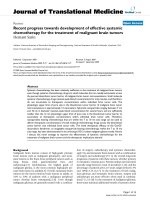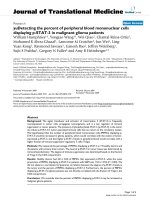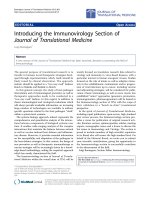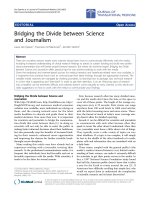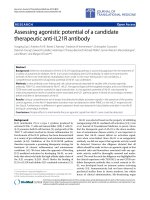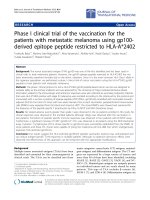báo cáo hóa học:" Assessing the construct validity of the Italian version of the EQ-5D: preliminary results from a cross-sectional study in North Italy" docx
Bạn đang xem bản rút gọn của tài liệu. Xem và tải ngay bản đầy đủ của tài liệu tại đây (250.81 KB, 9 trang )
BioMed Central
Page 1 of 9
(page number not for citation purposes)
Health and Quality of Life Outcomes
Open Access
Research
Assessing the construct validity of the Italian version of the EQ-5D:
preliminary results from a cross-sectional study in North Italy
Elena Savoia*
1
, Maria Pia Fantini
1
, Pier Paolo Pandolfi
2
, Laura Dallolio
1
and
Natalina Collina
2
Address:
1
Department of Medicine and Public Health, Alma Mater Studiorum University of Bologna, Italy and
2
Azienda USL di Bologna, Bologna,
Italy
Email: Elena Savoia* - ; Maria Pia Fantini - ;
Pier Paolo Pandolfi - ; Laura Dallolio - ;
Natalina Collina -
* Corresponding author
Abstract
Background: Information on health related quality of life (HR-QOL) can be integrated with other
classical health status indicators and be used to assist policy makers in resource allocation
decisions. For this reason instruments such as the SF-12 and EQ-5D have been widely proposed as
assessment tools to monitor changes in HR-QOL in general populations and very recently in
general practice settings as well
Aim: The primary goal of our study was to assess the construct validity of the Italian version of
the EQ-5D in a general population of North Italy using socio-demographic factors and diagnostic
sub-groups. Our secondary goal was to assess the concurrent validity of the EQ-5D and SF-12.
Methods: The SF-12, the EQ-5D plus an additional questionnaire on socio-demographic
characteristics, clinical conditions and symptoms were completed by 1,622 adults, randomly
selected from the Registry of the Health Authorities of the city of Bologna, Italy. The primary care
physician of each subject was contacted to report on the subject's health status.
Results: Our findings indicate that the Italian version of the EQ-5D is well accepted by the general
population (91% response rate), has good reliability (Cronbach's alpha 0.73), and shows evidence
of construct validity.
Conclusion: Our data provide a basis for further research to be conducted to assess the validity
of the EQ-5D in Italy. In particular future studies should focus on assessing its ability to detect a
clinically important change in health related quality of life over time (responsiveness).
Background
Improving the health of local populations requires spe-
cific knowledge of the current levels of health status,
which can be compared over time. However commission-
ing health care services carries with it the need to prioritize
resources. For this reason policy makers have always
expressed the necessity to identify variations within the
communities they are serving, compare local data with
normative population levels and eventually monitor
changes in health status by diagnostic and socio-demo-
Published: 10 August 2006
Health and Quality of Life Outcomes 2006, 4:47 doi:10.1186/1477-7525-4-47
Received: 13 March 2006
Accepted: 10 August 2006
This article is available from: />© 2006 Savoia et al; licensee BioMed Central Ltd.
This is an Open Access article distributed under the terms of the Creative Commons Attribution License ( />),
which permits unrestricted use, distribution, and reproduction in any medium, provided the original work is properly cited.
Health and Quality of Life Outcomes 2006, 4:47 />Page 2 of 9
(page number not for citation purposes)
graphic sub-groups. Information on health related quality
of life (HR-QOL) can be integrated with other classical
health status indicators and be used to assist policy mak-
ers in resource allocation decisions [1-3]. For this reason
instruments such as the SF-12 and the EQ-5D have been
widely proposed as assessment tools to assess HR-QOL in
general populations and very recently in general practice
settings as well [4-9].
The SF-12 is a generic short form health survey, originally
developed in the USA to provide a short alternative to the
SF-36 [10]. It produces two summary measures evaluating
physical and mental aspects of health derived from 12
questions. SF-12 has been successfully tested in several
European countries, including Italy, on large samples of
the general population, where it has proved its compre-
hensiveness, reliability, validity and cross-cultural appli-
cability. [11]
The EQ-5D is an internationally developed health related
quality of life measure that has been used throughout the
world. [12] The main difference with the SF-12 is that the
EQ-5D was developed as a preference-based measure,
suitable for cost-effectiveness analysis. The most interest-
ing characteristic of this instrument is the availability of a
"utility index score" which for the decision makers follow-
ing the principles of utilitarism makes the tool useful to
set priorities in clinical settings and policy determina-
tions. The utility view of quality of life refers to a subject's
preference for a state of health. This view describes quality
of life in a manner similar to the description of the bene-
fits of a life insurance policy, where different monetary
benefits are placed on the loss of various limbs. Although
the EQ-5D has been extensively utilized in non-Italian set-
tings, it lacks of empirical evaluations in Italy. The lack of
information on the construct validity and reliability of the
instrument as well as the absence of utilities estimated in
the Italian population preclude its applicability.
The primary goal of our study was to assess the applicabil-
ity, internal consistency, and construct validity of the Ital-
ian version of the EQ-5D in a random sample of the
citizens of Bologna (North Italy). Our secondary goal was
to test its concurrent validity with the SF-12.
Methods
Study population and data collection
A sample of 1,622 adults, aged 18–93, was randomly
selected (simple random sample) from the Registry of the
North and South Health Authorities of the city of Bolo-
gna, Italy. The adopted exclusion criteria were: people
aged < 18 years, non residents of the two Health Authori-
ties geographical areas, institutionalized subjects, and
people not able to reason or understand and make deci-
sions on their own. The study was performed in 2002 and
the sample was expected to be representative of the resi-
dents of the geographical area covered by the two Health
Authorities. A package with the SF-12 and the EQ-5D
questionnaires plus an additional questionnaire on socio-
demographic characteristics, clinical conditions and
symptoms was sent home to the 1,622 subjects. The pri-
mary care physician of each subject was contacted by mail
to report on the enrolled subject's health status by filling
out a questionnaire to be returned to the Health Author-
ity. In order to maximize the response rate each subject
was contacted by telephone three times after the 7
th
, 14
th
and the 21
st
day from the inception of the survey. Delin-
quency after the third phone call resulted in dropping out
the subject from the study and replacing her with a subject
(same age and gender) randomly selected from the origi-
nal sample. No reimbursement was offered to the study
participants.
Health status measurement
Two instruments were used to measure health related
quality of life: the SF-12 v.1 and the EQ-5D. The SF-12 is
a generic instrument that contains 12 items from the SF-
36 Health Survey. The SF-12 estimates scale scores for four
of the SF-36 eight health concepts (physical functioning,
role-physical, role-emotional and mental health) using
two items each; the remaining four health concepts (bod-
ily pain, vitality, social functioning and general health)
are each represented by a single item. We calculated the
summary scores PCS-12 and MCS-12 using the scoring
program described by Apolone [14].
The EQ-5D is a generic instrument, consisting of five
three-level items, representing various aspects of health:
mobility, self-care, usual activities, pain/discomfort and
anxiety/depression (mood). Respondents can value their
health in each domain by reporting whether they are expe-
riencing none (score 1), some (score 2) or extreme (score
3) problems. These scores result in a health profile, e.g. a
patient with profile 12113 has no problem with mobility,
usual activities and pain/discomfort, some problems with
self-care and extreme problems with anxiety/depression.
Data of a visual analogue scale are also included in the
EQ-5D and used by subjects to rate their health status
between worst imaginable health state (score 0) to best
imaginable health state (score 100). A utility index score
was calculated for each subject's EQ-5D health status by
applying the time trade-off-based valuations from a gen-
eral UK population sample to the observed EQ-5D pro-
file, as data from an Italian norm are not available at the
present time. Using the data at hand self-rated index were
also calculated using the EQ-VAS score method.
Health and Quality of Life Outcomes 2006, 4:47 />Page 3 of 9
(page number not for citation purposes)
Self-reported clinical conditions and socio-demographic
data
In the package shipped to the subjects we also included an
additional questionnaire to gather data on socio-demo-
graphic characteristics (gender, age, height, weight, level
of education, occupation and marital status) and to inves-
tigate clinical conditions and/or symptoms that based on
a literature search we hypothesized could affect everyday
life (i.e. headache) and do not necessary require a medical
consult or that are known to be reliable when self reported
(i.e. diabetes, in treatment for dialysis). [17-21]
The self-reported questionnaire focused on the following
symptoms or clinical conditions: visual impairment, hear-
ing impairment, anxiety/depression, headache, diabetes,
and dialysis. In addition a final open question was created
asking the subject to report on other clinical conditions
affecting her health status.
We used the level of education as proxy indicator of socio-
economic status because information on income was not
available. The level of education was described according
to the Italian school system into 5 categories: less than ele-
mentary school degree, elementary school degree, middle
school degree, high school degree, and college degree
equivalent to less than 5 years of school, between 5 and 8,
between 8 and 13 and more than 13 respectively.
We grouped the variable occupation into 7 categories: 1)
managers, professionals, directors, businessmen, 2) pub-
lic or private companies' employees, 3) labors, 4) house-
keeping, 5) retirees, 6) students and 7) unemployed.
Primary care physicians' assessments
The primary care physician of each subject was invited to
give a clinical assessment on the enrolled subject. In order
to gather such information in a structured and reliable
way we designed a questionnaire including the definition
of each investigated condition based on a review of the
most recent clinical guidelines. References to the adopted
guidelines were included and the questionnaire piloted
tested before implementation. The clinical conditions
included in the questionnaire were: hypertension, heart
failure, angina, COPD, asthma, back-pain, cancer (diag-
nosed in the past 5 years), stroke, cirrhosis, arthritis
(proved by X-ray documentation), myocardial infarction
(occurred in the past 5 years), and stomach ulcer (proved
by endoscopy).
Construct and concurrent validity assessment
Construct validity refers to the evaluation of hypotheses
about the expected performance of an instrument. A con-
struct can be thought as a mini-theory to explain the rela-
tionships among attitudes, behaviors, and perceptions as
well. Construct validation is an ongoing process of learn-
ing more about the construct, making new predictions
and then testing them. It is a process where the theory and
the measure are assessed at the same time [22]
Our approach in evaluating the EQ-5D construct validity
was based on comparisons of mean value scores (for the
EQ-5D index, EQ-self rated index and VAS) and ORs (for
the EQ-5D items) across categories such as diagnostic or
socio-demographic groups known or hypothesized to
score differently "known group validity". For example we
hypothesized that subjects of older age, with a lower edu-
cational attainment, female and unemployed scored
lower compared to younger, more educated, male and
employed subjects.
We also hypothesized that for the 14 identified diagnostic
sub-groups scores would have been lower compared to
healthy subjects.
The SF-12 was used to compare whether conceptually sim-
ilar domains had higher correlations than conceptually
unrelated domains.
Data analysis
Internal consistency of the multi-item EQ-5D scale was
calculated by means of Cronbach's α [22]. Average scores
for the EQ-5D index (based on the UK population), EQ-
self rated index, EQ-VAS, PCS-12 and MCS-12 scales were
computed, as well as the proportions of respondents
reporting impairment in the 5 EQ domains. The magni-
tude and significance of the ORs for the EQ-5D domains,
as well as the sign and significance of the regression coef-
ficients for the EQ-5D Index, EQ-self rated index, EQ-VAS,
PCS-12 and MCS-12 scores were used as discriminative
measurement tools in testing "known group validity". The
level of significance was set at 0.05. When the assumption
of linearity was satisfied we adjusted the sub-groups mean
scores for age and/or gender using linear regression. We
used logistic regression to adjust when dealing with cate-
gorical variables. Adjustment was performed because age
and gender are known to be associated with both scores of
health status and particular socio-demographic and clini-
cal variables. Therefore, considered as potential con-
founders. The effect of self-reported health problems and
of the physicians' reported diagnosis on the EQ-5D
dimensions was estimated using logistic regression while
the effect of the same variables on the EQ-5D index, EQ-
self rated index, EQ-VAS, PCS-12 and MCS-12 was esti-
mated using multivariate linear regression.
The concurrent validity of the EQ-5D and SF-12 in this
respondent sample was tested examining the relationship
between the self-reported EQ-5D and the SF-12 compo-
nent scores. The relationships between comparable
dimensions and component scores, such as anxiety/
Health and Quality of Life Outcomes 2006, 4:47 />Page 4 of 9
(page number not for citation purposes)
depression with the MCS-12 and mobility, self-care, usual
activities and pain/discomfort with the PCS-12 were
hypothesized to be stronger than between less compara-
ble dimensions and component scores, for example
mobility and the MCS-12. In contrast the EQ-VAS score
was expected to correlate reasonably well with both the
MCS-12 and PCS-12. The correlation between the EQ-
index (calculated on the UK population time trade off cri-
teria) and the EQ-self rated index was also computed. The
strength of the correlation was determined by Cohen's
(1992) criteria where large correlations are described as
being >0.50, medium correlations range between 0.30–
0.49 and small correlations range between 0.10–0.29.
The compare the "discriminant" validity of the two ques-
tionnaires we used the magnitude of ratio of the F-test
from multivariable analyses of variance. We hypothesized
the ratio to be greater for comparable dimensions such as
PCS-12 and the 4 EQ-functional dimensions compared to
non-comparable dimensions such as PCS-12 and the anx-
iety dimension.
Data were analyzed using Statistical Package for the Social
Sciences (SPSS) version 11.5.
Results
Response rates
Completed questionnaires were collected from 1,555 sub-
jects, 96% response rate. Of the 1,555 subjects 1,421
(91%) completed the EQ-5D, 1,326 (85%) the EQ-VAS,
and 1,364 (88%) the SF-12.
Considering the original sample 16.4% of non-respond-
ents were replaced. Thirty-six percent (524) of respond-
ents that completed all items of the EQ-5D reported no
problems (i.e. 11111) on all five dimensions. Of the 243
possible health states described by the EQ-5D, respond-
ents reported 47 different health states. Therefore the ceil-
ing effect of the EQ-5D was modest compared to other
studies [23].
Demographics of participants
The subject socio-demographic information is presented
in Table 1. The mean age (SD) of participants was 50.23
(18.13) years and ranged from 18 to 93, 52% were female.
More than half of subjects (60%) reported to have
achieved a middle school educational level. The most fre-
quent job position was public employee (21% of the total
sample) while 28% of participants were retirees. Most par-
ticipants were married (62%).
EQ-5D reliability and construct validity
Cronbach's coefficient α was 0.73 showing good reliabil-
ity of the instrument.
The mean EQ-5D index score (SD) was 0.81 (0.22) and
the mean EQ-VAS score (SD) was 77.0 (17.4). The EQ-
VAS sample mean score of 77.0 (17.4) was lower than the
general population norm of 82.5 (17) from the U.K. sam-
ple. [24]The Pearson correlation coefficient between the
EQ index and EQ-VAS was 0.65 (p < 0.001) and between
the EQ index and EQ-self rated index was 0.89 (p <
0.001). With the exception of the age category 25–34,
mean scores on both the EQ index and EQ-VAS decreased
with increasing category of age (Table 2). Age and gender
resulted to be determinants of the outcome "reporting
some or extreme problems" in each of the 5 dimensions
of the EQ with seniors and female reporting lower scores
(Table 2). The adopted proxy indicator of socio-economic
status (educational level) was related to the presence of
severe or moderate symptoms in the 5 dimensions of the
EQ, and low scores in the EQ-index and EQ-VAS, even
after adjusting for age and gender simultaneously. There-
fore socio-economic status was negatively related to qual-
ity of life. Among the different marital status widowed
showed the highest significantly different percentage of
reported problems on the EQ dimensions with the excep-
Table 1: Socio-demographic variables.
Characteristic N %
Age (years)
18–24 95 6.3
25–34 268 17.9
35–44 273 18.2
45–54 254 17.0
55–64 229 15.3
65–74 205 13.7
> 75 173 11.6
Gender
Male 718 48
Female 779 52
Education
< 5 years 49 3
5 years 435 29
8 years 402 27
13 years 490 33
> 13 years 104 7
Occupation
Manager/Director 32 2
Professional 80 6
Business man 179 12
Employee 305 21
Labors 193 13
House keeping 169 12
Student 44 3
Retired 410 28
Unemployed 25 2
Marital status
Single 380 25.5
Married 930 62.4
Widowed 149 10.0
Divorced/Separated 31 2.1
Health and Quality of Life Outcomes 2006, 4:47 />Page 5 of 9
(page number not for citation purposes)
tion of anxiety and depression, low scores were reported
in the EQ index and EQ-VAS as well, always adjusting for
age and gender. We did not find a linear relationship
between occupational status and quality of life. However
we demonstrated a difference in quality of life in the mean
scores ANOVA F-test (p < 0.001) after adjusting for age
and gender. Among occupations, retirees reported the
lowest scores.
With respect to the clinical conditions referred by the
patient all were significantly associated with increased
odds of reporting impairment in all 5 EQ dimensions.
Results are displayed in table 3. In particular visual
impairment and hearing impairment were the ones with
the greatest impact on mobility, self-care and usual activ-
ities. For subjects affected by visual impairment compared
to subjects not affected by the clinical condition we
obtained a 600% increased odds of reporting impairment
in the mobility domain (OR = 7.0, 95% C.I. 4.7–10.4), a
690% increased odds of reporting impairment in the self
care domain (OR = 7.9 95% C.I. 4.8–12.9) and a 640%
increased odds of reporting impairment in the usual activ-
ities domain (OR = 7.4, 95% C.I. 5.0–10.9). Visual
impairment was asked as a persistent condition not solved
Table 2: Responses to the EQ-5D and SF-12 by socio-demographic characteristics.
Variable % Reporting a problem (moderate or severe) for categorical variables or mean value for numeric variables.
PCS MCS Mobility Self-care Usual activities Pain/discomfort Anxiety/
depression
EQ-5D
index
EQ-5D
vas
Total
sample
48.4 47.7 13.6 5.8 14.1 45.4 39.3 0.8 77.0
Age
α
**********
18–24 50.3 48.5 4.3 3.2 4.3 30.1 44.1 0.8 81
25–34 50.8 47.7 7.6 3.8 10.3 40.2 38.3 0.8 80
35–44 50.3 48.5 10.4 5.4 10.3 42.6 32.0 0.8 79
45–54 49.2 48.0 7.3 2.4 9.7 45.7 40.0 0.8 80
55–64 48.2 47.6 14.7 6.7 17.6 53.6 50.7 0.8 76
65–74 46.1 47.4 21.2 2.6 18.2 59.6 44.7 0.8 74
> 75 42.4 45.3 40.0 21.8 37.3 67.3 53.3 0.7 68
Gender
β
**********
Male 50.0 49.5 9.6 4.3 10.1 40.8 31.9 0.8 80
Female 46.8 45.8 19.2 8.0 19.8 56.2 51.9 0.8 75
Occupatio
n
δ
*******
1 54.6 42.5 4.0 0 8.0 32.0 48.0 0.9 75
2 43.7 46.2 29.3 13.2 26.6 64.6 52.5 0.7 70
3 50.3 50.3 4 1.1 7.0 43.0 37.1 0.9 82
4 43.7 45.1 21.0 20.7 19.1 16.8 16.5 0.7 70
5 53.9 46.5 0.5 - 1.0 1.3 2.4 0.9 85
6 42.5 46.6 64.9 71.3 56.9 39.1 34.5 0.7 67
7 54.4 42.5 0.5 - 1.0 1.2 2.0 0.9 75
>Educatio
nal level γ
*********
< 5 years 36.8 41.4 50.0 29.8 48.9 87.5 60.4 0.55 60.7
5 years 43.3 46.5 30.9 12.8 27.6 65.1 49.5 0.72 68.7
8 years 49.4 48.5 8.2 3.3 11.5 49.2 45.4 0.82 79.2
13 years 51.8 48.4 4.2 1.5 5.8 33.3 32.4 0.88 82.6
> 13
years
52.9 48.1 2.0 1.0 2.9 32.7 38.2 0.88 83.2
Marital
status
Single
γ
52.5* 49.0 6.6* 5.6** 11.0** 15.7* 19.2** 0.88* 82.9*
Married
γ
48.0 47.6 60.2 52.8 60.7 67.8* 65.5* 0.81 77.0
Widowe
d
γ
39.1* 44.3** 31.3** 39.3** 26.5** 14.6** 13.0 0.61* 63.2*
Divorced
γ
51.5** 47.7 1.9 2.2 1.8 2.0 2.3 0.80 81.2
α
adjusted for gender;
β
adjusted for age;
γ
adjusted for age and gender; *p <0.001 **p <0.05
δ
1 = manager, director, business-man; 2 = public employee; 3 = labor, 4 = house keeping, 5 = student, 6 = retiree, 7 = unemployed.
Health and Quality of Life Outcomes 2006, 4:47 />Page 6 of 9
(page number not for citation purposes)
Table 3: Responses to the EQ-5D and SF-12 by clinical condition.
Clinical Condition (n) OR of reporting an impairment Beta coefficient
Mobility
α
Self-care
α
Usual activities
α
Pain/discomfort
α
Anxiety/depression
α
EQ-5D
index α-
UK
EQ-5D
vas
α
EQ-VAS
score
Diabetes (59) 4.8 (2.7–8.7) 4.8 (2.4–9.5) 3.5 (1.9–6.2) 2.8 (1.5–5.2) 1.7 (1.0–3.0) -0.11* -0.19* -0.13*
Without (1423)
Visual impairment (159) 7.0 (4.7–10.4) 7.9 (4.8–12.9) 7.4 (5.0–10.9) 4.0 (2.6–6.1) 2.6 (1.8–3.7) -0.32* -0.34* -0.34*
Without (1295)
Hearing impairment (204) 5.8 (4.0–8.3) 5.3 (3.3–8.4) 4.7 (3.3–6.7) 3.3 (2.3–4.6) 2.1 (1.5–2.9) -0.24* -0.24* -0.25*
Without (1275)
Anxiety (233) 2.5 (1.7–3.6) 3.2 (2.0–5.2) 2.9 (2.1–4.2) 2.0 (1.5–2.7) 17.1 (10.9–26.9) -0.31* -0.26* -0.29*
Without (1234)
Head ache at least once a week (351) 1.7 (1.2–2.3) 1.6 (1.0–2.6) 1.9 (1.4–2.7) 4.0 (3.0–5.4) 2.4 (1.8–3.1) -0.24* -0.13* -0.20*
Without (1118)
Hypertension (277) 4.0 (2.8–5.8) 4.6 (2.7–7.7) 2.9 (2.0–4.2) 1.8 (1.3–2.5) 1.5 (1.1–2.0) -0.19* -0.29* -0.20*
Without (875)
Heart failure (35) 22.0 (8.6–56.0) 21.0 (9.4–46.3) 14.1 (6.0–33.2) 4.3 (1.6–11.5) 2.2 (0.9–4.9) -0.25* -0.23* -0.25*
Without (1125)
Angina (21) 3.3 (1.2–8.6) 4.5 (1.5–13.4) 5.3 (2.1–13.6) 1.9 (0.7–5.3) 3.1 (1.1–8.3) -0.09** -0.11** -0.10**
Without (1140)
COPD (84) 4.4 (2.6–7.5) 3.0 (1.5–6.0) 4.8 (2.8–8.2) 3.3 (1.9–5.8) 1.2 (0.7–2.0) -0.14* -0.21* -0.19*
Without (1075)
Asthma (39) 1.3 (0.5–3.0) 2.4 (0.9–6.5) 3.1 (1.5–6.5) 1.2 (0.6–2.5) 1.6 (0.8–3.2) -0.06** -0.07** -0.07**
Without (1140)
Back pain (327) 4.6 (3.2–6.7) 3.0 (1.8–5.1) 2.9 (2.1–4.2) 3.6 (2.7–4.9) 1.5 (1.1–1.9) -0.25* -0.28* -0.25*
Without (814)
Stomach ulcer (35) 1.9 (0.8–4.3) 2.0 (0.7–5.8) 2.9 (1.4–6.3) 3.6 (1.5–8.6) 1.6 (0.8–3.3) -0.12* -0.08** -0.10*
Without (1120)
Arthritis (314) 7.8 (5.3–11.6) 3.7 (2.2–6.2) 4.1 (2.8–5.8) 4.5 (3.3–6.3) 1.5 (1.1–2.0) -0.3* -0.35* -0.32*
Without (833)
Obesity (BMI >30) (163) 3.5 (2.3–5.2) 1.9 (1.1–3.4) 2.2 (1.4–3.3) 1.7 (1.2–2.4) 1.3 (0.9–1.8) -0.08** -0.12* -0.11*
Without (1283)
α
Adjusted for age and gender where * p <0.001 and ** p <0.05
Health and Quality of Life Outcomes 2006, 4:47 />Page 7 of 9
(page number not for citation purposes)
by the use of glasses. For subjects affected by hearing
impairment compared to subjects not affected by the clin-
ical condition we obtained a 480% increased odds of
reporting impairment in the mobility domain (OR = 5.8,
95% C.I. 4.0–8.3), a 430% increased odds in the self-care
domain, and a 370% increased odds in the usual activities
domain (OR = 4.7, 95% C.I. 3.3–6.7). Having a headache
at least once a week affected mainly the pain and discom-
fort domain with a 300% increased odds of reporting
impairment compared to subjects not affected by the clin-
ical condition (OR = 4.0, 95% C.I. 3.0–5.4)
Subjects reporting to be affected by anxiety and to be in
treatment for the condition were 17.1 times more likely to
report impairment in the anxiety and depression domain
compared to subjects not affected by the condition (OR =
17.1, 95% C.I. 10.9–26.9)
Diabetes was associated to all 5 dimensions with ORs
ranging from 4.8 (95% C.I. 2.7–8.7) in the mobility
domain to 1.7 (95% C.I. 1.0–3.0) in the anxiety and
depression domain.
With respect to the clinical conditions referred by the sub-
ject's primary care physician all were significantly associ-
ated with increased odds of reporting impairment in all 5
EQ dimensions. Table 3. Most of them were strongly asso-
ciated to increased odds of reporting impairment in the
mobility domain. In particular heart failure is the one
showing the greatest odds (OR = 22.0, 95% C.I. 8.6–
56.0). But also arthritis, back pain, COPD, and obesity
(BMI>30) were strongly associated to mobility impair-
ment. Angina, asthma and COPD mainly affected the
usual activities domain. Angina was associated with the
anxiety and depression domain with 210% increased
odds of reporting impairment (OR = 3.1, 95% C.I. 1.1–
8.3) compared to subjects not affected by the clinical con-
dition. Stomach ulcer was mainly associated with the pain
and discomfort domain with 260% increased odds of
reporting impairment (OR = 3.6, 95% C.I. 1.5–8.6) com-
pared to subjects not affected by this condition.
All clinical conditions showed a negative impact on HR-
QOL when the EQ-5D index, EQ-self rated index and the
EQ-VAS scores were taken into considerations. Applying a
linear regression model, adjusting for age and gender,
regression coefficients ranged from – 0.08 (p < 0.005) for
obesity and stomach ulcer impacting the EQ-5D index
and EQ-5D VAS score respectively and -0.35 (p < 0.001)
for arthritis impacting the EQ-VAS score, results are
shown on Table 3.
EQ-5D and SF12 concurrent validity
As expected the relationships were stronger between the
EQ-5D functional dimensions and the PCS-12, and
between the MCS-12 and the anxiety/depression dimen-
sion. As a matter of fact the correlation coefficients
between PCS-12 and the functional dimensions ranged
from 0.65 for the usual activities domain to 0.43 for the
self-care domain. As expected the MCS-12 score well cor-
related with the anxiety and depression domain r = 0.59.
The relationships between the less comparable dimen-
sions and the component scores were not as strong. In fact
the correlation coefficients between the MCS-12 and the
physical items ranged from 0.34 for the usual activities
domain to 0.25 for the self-care and mobility domains.
While the PCS-12 score correlated with the anxiety and
depression domain with a coefficient as low as of 0.29.
The EQ-VAS scores were positively correlated with both
component scores; r = 0.46 for MCS-12 and r = 0.66 for
PCS-12. All correlations were significant with p-value <
0.001.
In addition corresponding dimensions and summary
scores were more strongly related (eg, mobility and PCS-
12; F ratio = 401.45, p-value < 0.001, or anxiety and MCS;
F ratio = 356.8, p-value < 0.001) than dissimilar dimen-
sions (eg, mobility and MCS-12; F ratio = 46.8 or anxiety
and PCS-12 F ratio = 63.6, p-value < 0.001).
Discussion
In this study we investigated the construct validity of the
Italian version of the EQ-5D administering the instru-
ment to a sample of citizens living in Bologna (North
Italy). We provided evidence supporting the construct
validity and reliability of the instrument supported by
data on socio-demographic characteristics and diagnostic
sub-groups of the participants. Strength of our study was
the achieved high response rate and the primary care phy-
sicians' support in assessing each subject's health status.
The instrument resulted to be consistent with the hypoth-
esized construct and showed good reliability. The conver-
gent and discriminant validity of the EQ-5D were also
supported by the relationship with the SF-12 component
scores observed in the data, with stronger relationships
observed between the PCS-12 scores and the functional
dimensions than with the anxiety/depression dimension.
Likewise the MCS-12 scores differentiated the level of anx-
iety/depression dimension more strongly than for the lev-
els of the functional dimensions of mobility, self-care,
usual activities and pain/discomfort.
We consider our results as a preliminary step towards the
empirical validation process of the EQ-5D in Italy. How-
ever some limits of our research should be taken into con-
sideration.
Our sample was representative of two health district areas
of the city of Bologna, the Italian territory is extremely het-
Health and Quality of Life Outcomes 2006, 4:47 />Page 8 of 9
(page number not for citation purposes)
erogeneous in terms of population characteristics such as
age, socio-economic status, health status and life-style. In
particular differences are present in most health indicators
between the North and South of the country. Therefore
any inference on the Italian population should be cau-
tious. The utility value calculated for the EQ-5D was based
on the U.K. population norm data, debate on the cross
adaptability of such scores has not been solved yet. The
absence of values based on the Italian population affects
the most important characteristic of the instrument,
which is its use in cost-effectiveness analysis. However
EQ-self rated index scores were derived and showed a high
correlation with the UK EQ-index scores.
A known limit of the EQ-5D is to have a 3 responses for-
mat, as a consequence subject to a considerable ceiling
effect. However in our sample it appeared that the dimen-
sions were discriminative enough to distinguish between
respondents with and without specific clinical conditions.
An other limit of our study was not being able to assess the
instrument's responsiveness, which is extremely impor-
tant for its use in monitoring a population's health status.
Conclusion
Our data provide evidence on the construct validity of the
Italian version of the EQ-5D in a general population of a
large city in North Italy. The measurements of the EQ-5D
behaved in patterns that were consistent with recognized
socio-demographic differences in health status.
Future studies should focus on assessing the instrument's
ability to detect a clinically important change in health
related quality of life over time (responsiveness) in order
to be able to adopt the tool to monitor a population's
health status. However in addition to a psychometric
approach measurement/metric equivalence of the Italian
version of the EQ-5D should also be investigated. In par-
ticular the clinically minimal important difference
(MCID), which is defined as the smallest difference
between the scores in a questionnaire that the patient per-
ceives to be beneficial should be assessed in an Italian
sample should be assessed. A national effort in designing
a study with a representative sample of the Italian popula-
tion will be a necessary step to increase evidence on the
EQ-5D applicability in Italy.
Competing interests
The author(s) declare no competing interest in the con-
duction of the study.
Authors' contributions
Dr. Pandolfi designed and led the study, Dr. Collina led
the implementation of the study in the health district
under her authority, Dr. Fantini offered methodological
support in designing the study and for the data manage-
ment plan, Dr. Dallolio coordinated data entry and data
analysis, Dr. Savoia provided assistance with data analysis
and the narrative of the manuscript. All authors revised
the text and provided information and comments to its
final version.
References
1. Institute of Medicine: Summarizing Population Health: Directions for the
Development and Application of Population Metrics Edited by: Field MJ,
Gold MR. Washington, D.C.:National Academy Press; 1998.
2. Murray CJL, Lopez AD, Mathers CD, Stein C: The Global Burden
of Disease 2000 project: Aims, methods, and data sources. In
Global Programme on Evidence for Health Policy Discussion Paper No. 36
World Health Organization; 2001.
3. Gold MR, Muennig P: Measure-dependent variation in burden
of diseases estimates: Implication for policy. Med Care 2002,
40:260-266.
4. Ware JE, Kosinski M, Keller SD: A 12-item Short Form Health
Survey: construction of scales and preliminary test of relia-
bility and validity. Med Care 1996, 34:220-226.
5. Lam CL, Fong DY, Lauder IJ, Lam TP: The effect of health-related
quality of life (HRQOL) on health service utilisation of a Chi-
nese population. Soc Sci Med 2002, 55:1635-1646.
6. Johnson JA, Coons SJ: Comparison of the EQ-5D and SF-12 in
an adult US sample. Qual Life Res 1998, 7:155-166.
7. Rabin R, de Charro F: EQ-5D: A measure of health status from
the EuroQol Group. Ann Med 2001, 33:337-343.
8. Brazier J, Jones N, Kind P: Testing the validity of the Euroqol
and comparing it with the SF- 36 health survey question-
naire. Qual Life Res 1993, 2:169-180.
9. Johnson JA, Pickard AS: Comparison of the EQ-5D and SF-12
health surveys in a general population survey in Alberta,
Canada. Med Care 2000, 38:115-121.
10. Zahran HS, Kobau R, Moriarty DG, Zack MM, Holt J, Donehoo R:
Centers for Disease Control and Prevention (CDC). Health-
related quality of life surveillance – United States, 1993–
2002. MMWR Surveill Summ 2005, 54:1-35.
11. Gandek B, Ware JE, Aaronson NK, Apolone G, Bjorner JB, Brazier JE,
et al.: Cross-validation of items selection and scoring for the
SF-12 Health Survey in 9 countries: results from the IQOLA
project. J Clin Epidemiol 1998, 51:1171-1178.
12. Kodraliu G, Mosconi P, Groth N, Carmosino G, Perilli A, Gianicolo
EA, et al.: Subjective health status assessment: evaluation of
the Italian version of the SF-12 Health Survey. Results from
the MiOS project. J Epidemiol Biostat 2001, 6:305-316.
13. Rabin R, de Charro F: EQ-5D: A measure of health status from
the EuroQol Group. Ann Med 2001, 33:337-343.
14. Apolone G, Mosconi P, Quattrociocchi L, Gianicolo E, Groth N,
Ware J: Questionario sullo stato di salute SF-12. Guerini e Asso-
ciati 2001.
15. Tobiasz-Adamczyk B, Brzyski P: Factors determining changes in
self-rated health in the Polish community-dwelling elderly.
Cent Eur J Public Health 2005, 13:117-124.
16. Alonso J, Ferrer M, Gandek B, Ware JE Jr, Aaronson NK, Mosconi P,
Rasmussen NK, Bullinger M, Fukuhara S, Kaasa S, Leplege A, IQOLA
Project Group: Health-related quality of life associated with
chronic conditions in eight countries: results from the Inter-
national Quality of Life Assessment (IQOLA) Project. Qual
Life Res 2004, 13:283-298.
17. Jiang Y, Hesser JE: Associations between health-related quality
of life and demographics and health risks. Results from
Rhode Island's 2002 Behavioral Risk Factor Survey. Health
Qual Life Outcomes 2006, 4:14.
18. Lubetkin E, Jia H, Franks P, Gold MR: Relationship among socio-
demographic factors, clinical conditions, and health-related
quality of life: Examining the EQ-5D in the U.S. general pop-
ulation. Qual Life Res 2005, 14:2187-2196.
19. Jelsma J, Ferguson G: The determinants of self-reported health-
related quality of life in a culturally and socially diverse South
African community. Bull World Health Organ 2004, 82:206-212.
Publish with BioMed Central and every
scientist can read your work free of charge
"BioMed Central will be the most significant development for
disseminating the results of biomedical research in our lifetime."
Sir Paul Nurse, Cancer Research UK
Your research papers will be:
available free of charge to the entire biomedical community
peer reviewed and published immediately upon acceptance
cited in PubMed and archived on PubMed Central
yours — you keep the copyright
Submit your manuscript here:
/>BioMedcentral
Health and Quality of Life Outcomes 2006, 4:47 />Page 9 of 9
(page number not for citation purposes)
20. Lacey EA, Walters SJ: Continuing inequality: Gender and social
class influences on self perceived health after a heart attack.
J Epidemiol Commun Health 2003, 57:622-627.
21. Franks P, Gold MR, Fiscella K: Sociodemographics, self rated
health, and mortality in the US. Soc Sci Med 2003, 56:2505-2514.
22. Streiner DL, Norman GR: New York, NY: Oxford University Press,
Health measurement scales; 1992.
23. Lubetkin EI, Jia H, Gold MR: Construct validity of the EQ-5D in
low income Chinese American primary care patients. Qual
Life Res 2004, 13:1459-1468.


